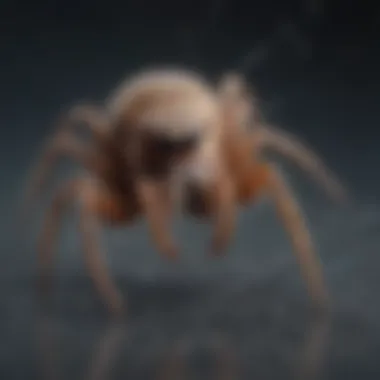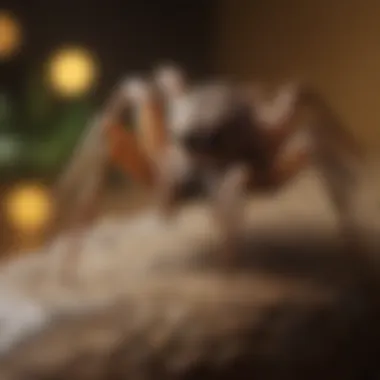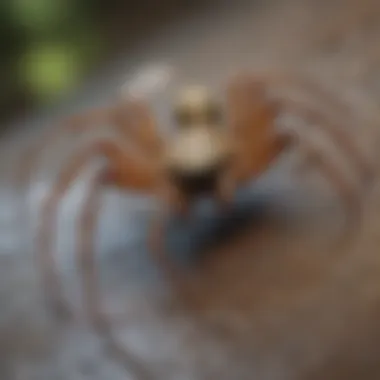Effective Strategies for Eliminating Indoor Spiders


Intro
Identification of Common Pests
Description of Common Pests
It is essential to identify the types of spiders that may inhabit your home. Common pests include the house spider, which is generally harmless but can proliferate rapidly; the black widow, known for its distinctive markings and more dangerous bite; and the brown recluse, which may pose health risks. Knowing the species helps in both preventive measures and control strategies.
Signs of Infestation
Recognizing the signs of spider infestation plays a vital role in timely intervention. Look for the following indicators:
- Webs in corners of rooms, particularly in less-frequented areas.
- Egg sacs, which are small and often found attached to webbing or corners.
- Droppings that resemble small black specks, indicating activity.
If you notice these signs, it is crucial to act swiftly to mitigate potential infestations.
Prevention Techniques
Home Maintenance Tips
Maintaining a clean and clutter-free environment is a key strategy for preventing spider infestations. Consider implementing some of the following practices:
- Regularly vacuum corners, baseboards, and behind furniture to remove webs and egg sacs.
- Seal cracks and crevices around windows, doors, and the foundation of your home to limit spider entry.
- Reduce outdoor lighting near entrances, as bright lights attract flying insects, which in turn can attract spiders.
Environmental Modifications
In addition to home maintenance, adjusting your surroundings can further deter spiders:
- Keep firewood and other materials stored away from the house to reduce nesting sites.
- Ensure that gutters and downspouts are free from debris, as stagnant water can attract moisture-loving pests.
- Trim back vegetation around your home's perimeter to minimize spider habitat.
Eco-Friendly Pest Control Options
Natural Pesticides
For those seeking alternatives to chemical pesticides, natural solutions can be effective. Some options include:
- Peppermint oil: Known for its strong scent, it can repel spiders. Dilute with water and spray in areas where spiders are seen.
- Diatomaceous earth: This powder can dehydrate and kill spiders upon contact. Sprinkle in areas where spiders are commonly found.
Organic Pest Control Techniques
Integrating organic techniques into your pest control regimen supports environmental health. Here are a few recommendations:
- Use vinegar and water solution to clean surfaces; spiders dislike the strong smell.
- Create barriers using citrus peels or essential oils like tea tree or lavender, as these scents deter spiders.
Maintaining a clean living space paired with proactive measures can significantly reduce the likelihood of spider infestations.
By employing strategies for identification, prevention, and control, one can effectively manage spider populations while ensuring a safe living environment. This comprehensive approach is particularly useful for homeowners seeking to maintain their home's comfort.
Understanding the Spider Problem
Spiders, while often misunderstood, can present a notable problem in indoor spaces. Recognizing the significance of addressing spider infestations is key for anyone who wants to maintain a safe and comfortable home environment. Ignoring spider presence can lead to increased population growth, creating a more challenging issue to manage later. Moreover, some species may pose health risks, especially to children and pets. For home owners and housewives, knowing how to effectively eliminate these pests offers not only peace of mind but also protection against potential allergies or bites.
Importance of Addressing Spider Infestations
Addressing spider infestations promptly is essential for several reasons. First, spiders reproduce quickly, and a small number can multiply into a significant population within a short time. As they thrive in hidden corners, attics, and basements, many individuals may not realize the extent of an infestation until it becomes overwhelming. Furthermore, control measures are easier and more effective when taken early. Implementing strategies early allows home owners to minimize the need for drastic measures down the line.
The presence of certain spiders can also indicate other pest problems in the home. For instance, a surplus of spiders might suggest a problem with insects, which could draw spiders into the living areas. Therefore, addressing spiders not only solves a direct problem but may also uncover underlying issues requiring attention.
Common Misconceptions About Spiders
There are several misconceptions about spiders that can hinder effective management. Many people believe that all spiders are dangerous. In reality, most species found indoors are harmless and may even provide a benefit by controlling other pests. Understanding this can help reduce unnecessary fear and promote a more rational approach to control.


Another commonly held belief is that spiders come from outside only. While outdoor spiders may venture indoors, many can establish themselves, thriving in the home environment due to available food sources and suitable shelter. This highlights the importance of maintaining cleanliness and proper maintenance indoors, as clutter and food residue can attract these spiders.
Finally, many individuals think that erratic cleaning or the use of harsh chemicals are the only means of control. Yet, effective spider management combines preventive methods with targeted interventions that do not necessarily require extreme measures. By debunking these misconceptions, home owners can adopt more effective strategies that balance ecological considerations with comfort.
Identifying Spider Species
Identifying spider species in your home is crucial for effective control and management of spider populations. Not all spiders pose a threat, and many are beneficial for the ecosystem. By recognizing which spiders you are dealing with, you can tailor your approach to suit specific situations. Understanding spider behavior and habits helps in choosing the right prevention methods and treatment options. Knowing whether a spider is venomous or non-venomous can significantly impact your response strategies and ultimately your safety.
Common Types of Indoor Spiders
Several spider species commonly invade indoor spaces. Familiarizing yourself with these can aid in better management:
- Common House Spider (Parasteatoda tepidariorum): This spider has a round body and is often gray or brown. It constructs webs in corners.
- Wolf Spider (Lycosidae family): Wolf spiders are agile and do not weave webs. They hunt their prey actively, often found in dark areas without webs.
- Cellar Spider (Pholcidae family): With long legs and small bodies, cellar spiders make a mess of webs. They are often found in basements and corners.
- Black Widow (Latrodectus species): Recognizable by their glossy black bodies and red hourglass marking, these spiders can be dangerous to humans.
- Brown Recluse (Loxosceles reclusa): Known for its violin-shaped marking on the back, this spider is venomous and can cause serious bites.
Understanding these species helps homeowners act wisely. Some spiders can actually help control pest populations.
Recognizing Venomous vs. Non-Venomous Spiders
Differentiating between venomous and non-venomous species is essential for safety. Here are some distinguishing characteristics:
- Venomous Spiders: Typically, these spiders have noticeable markings, such as the red hourglass of the black widow. Their bites can cause serious health issues and require medical attention.
- Non-Venomous Spiders: Most common household spiders fall into this category. Their bites might be annoying but usually do not cause severe reactions.
Key Indicators to Observe:
- Body Shape and Size: Venomous spiders often have distinct body shapes. Black widows, for example, have hourglass shapes.
- Location: Venomous species prefer dark, secluded spaces.
- Behavior: Non-venomous spiders tend to be less aggressive. They may flee rather than confront humans.
Understanding these features is vital as it guides you in determining when to take action against spiders in your home.
Preventive Measures to Deter Spiders
Being proactive in preventing spiders is crucial in maintaining an indoor environment that is both comfortable and safe. Having a strategy to deter these arachnids greatly reduces the chances of an infestation. Preventive measures can save time, money, and provide peace of mind. A clean, sealed, and well-maintained home is fundamentally less appealing to spiders.
Maintaining Clean Indoor Spaces
Importance of Regular Cleaning
Regular cleaning is a fundamental strategy to eliminate spiders. Dusting and vacuuming weekly can remove spider webs and potential food sources, such as other insects. This consistency in cleaning not only reduces spiders but also contributes to overall household hygiene. Many people find regular cleaning a beneficial habit. It ensures that living spaces remain less cluttered and free from pests. However, this method requires dedication and time.
Removing Clutter and Hiding Places
Clutter often provides spiders with hiding places. Removing unnecessary items like old boxes or seldom-used furniture is imperative. When indoor spaces are organized, spiders have fewer places to conceal themselves. Such measures lead to better air circulation and a sense of order in the home. Nevertheless, some may find it challenging to declutter, over time, the benefits outweigh the initial discomfort.
Sealing Entry Points
Inspecting Doors and Windows
Inspecting doors and windows is vital in preventing spider infestations. Gaps can serve as entry points for spiders looking for a new home. By ensuring that seals are intact and fixing any damage, homeowners create a barrier against these pests. This simple task is a popular choice because it can significantly reduce the likelihood of spider incursions. However, thorough inspections may require time and attention.
Using Caulk and Weather Stripping
Using caulk and weather stripping is an effective solution. These materials fill gaps around doors and windows, preventing spiders from entering. Many find this method appealing due to its straightforward application. It creates a tight seal and minimizes energy loss, which can lead to additional cost savings in heating and cooling. The downside is that regular checks are needed to ensure the integrity of these seals over time.
Outdoor Maintenance and Landscaping
Trimming Vegetation Near Home
Trimming vegetation near the home can significantly deter spiders. Overgrown plants provide shelter and hunting grounds for spiders, which can lead them closer to the house. This maintenance step not only beautifies the outdoor space but also reduces the risk of a spider problem. Many homeowners find this solution practical and easy to implement. However, this requires periodic attention and care to maintain the landscape properly.
Controlling Outdoor Lighting
Controlling outdoor lighting helps minimize insect attraction, which in turn reduces spiders. Bright lights draw moths and other prey insects, enticing spiders to your home. By switching to yellow or sodium vapor lights, homeowners can reduce this undesired attraction. This measure is cost-effective and can greatly enhance outdoor spaces as well. The main consideration is to find suitable lighting options while ensuring visibility and security outside the home.


Maintaining a proactive approach is not just about reducing spider sightings; it is about creating a balanced indoor and outdoor environment that discourages pests.
Natural Remedies for Spider Control
Natural remedies for spider control are crucial as they present eco-friendly options for managing unwanted eight-legged inhabitants in the home. Many homeowners prefer to avoid harsh chemicals, making natural solutions appealing. In addition to being safer for children and pets, these remedies can also be cost-effective and easy to implement. Understanding how to utilize these natural methods can lead to a more harmonious living environment where spiders are less likely to invade.
Essential Oils and Their Effectiveness
Peppermint Oil
Peppermint oil stands out as an effective natural spider deterrent. Its strong scent is known to repel many insects, including spiders. The aroma disrupts their sensory responses, making the environment less inviting. Because peppermint oil is widely available and easy to use, many choose it as a primary option for spider control in their homes.
Using peppermint oil involves diluting it with water and spraying the solution in areas where spiders are likely to appear. One key characteristic of peppermint oil is its invigorating fragrance, which not only acts as a deterrent but can also freshen indoor spaces. However, a minor drawback is that frequent reapplication is necessary to maintain its effectiveness.
Tea Tree Oil
Tea tree oil is another popular choice for spider control. Its antifungal and antibacterial properties contribute to a cleaner environment, potentially reducing spider presence. With a unique ability to penetrate the outer layers of pests, tea tree oil disrupts their normal functioning.
Its key characteristic lies in its strong scent, which can repel spiders effectively. Tea tree oil serves dual purposes as a cleaning agent, making it a practical option for homeowners. On the downside, the pungent odor can be overwhelming for some, requiring careful usage in enclosed spaces.
Diatomaceous Earth as a Pest Control Method
Diatomaceous earth (DE) is an intriguing option for spider control. This natural powder is composed of fossilized algae, and its abrasive texture can damage the exoskeletons of insects. When spiders come into contact with DE, it causes dehydration. Its effectiveness makes diatomaceous earth a good choice for those seeking minimal chemical intervention.
To use DE, scatter it in areas prone to spider activity. It is important to note that while it is effective, DE must remain dry to maintain its pest control properties. Regular application may be necessary in high-humidity environments.
Vinegar Solutions to Repel Spiders
Vinegar is another simple household item that can act as a spider repellent. The acetic acid present in vinegar creates an environment that is unappealing to spiders. When mixed with water and sprayed in strategic locations around the house, vinegar can help to keep spiders at bay.
While vinegar is non-toxic and environmentally friendly, its strong smell may deter some. This temporary odor typically dissipates quickly, making it a feasible option for ongoing spider control. However, homeowners should be mindful that vinegar's effectiveness may not be as long-lasting as some other methods, necessitating frequent application.
Natural remedies provide an accessible means of managing indoor spiders without relying on harsher chemicals. Their use can encourage a sustainable approach to pest control.
Chemical Solutions for Spider Elimination
Chemical solutions play a significant role in the management and elimination of spiders within indoor spaces. While prevention and natural remedies are effective, sometimes a more direct approach is necessary. Chemical sprays are formulated to target various pests, including spiders, providing quick results. Homeowners may consider chemical solutions when other methods fail to yield the desired outcome. However, these solutions must be approached with caution, as they can pose risks to health and the environment if not used properly. Understanding the different types of chemical sprays and the necessary safety precautions is crucial to maintaining a safe living space while effectively controlling spider populations.
Types of Chemical Sprays Available
There are several types of chemical sprays available for spider control, each designed to target specific needs. The most common categories include:
- Insecticides: These sprays are typically designed for a wide range of pests, including spiders. They contain chemicals that disrupt the nervous system of the insects. Common brands include Raid and Ortho.
- Residual Sprays: They leave a residue on surfaces that can continue to kill spiders for weeks after application. Examples are EcoSMART and Talstar.
- Foggers and Aerosols: These are useful for treating large areas in a short amount of time. Brands like Hot Shot offer effective fogging solutions.
Each type has its advantages and ideal situations for use. The choice of spray often depends on the severity of the infestation and the specific environment in which it will be applied.
Safety Precautions When Using Chemicals
When employing chemical solutions for spider elimination, safety is paramount. Users should always follow the manufacturer's instructions and take precautions to avoid potential hazards. Two critical aspects of safety include protective gear and adequate ventilation.
Protective Gear
Wearing protective gear is essential when applying chemical sprays. This gear often includes gloves, goggles, and masks to safeguard against skin and respiratory exposure. The key characteristic of protective gear is its ability to shield the user from direct contact with harmful chemicals. It is a popular choice in this context because it significantly reduces the risk of adverse health effects.
Some unique features of protective gear include waterproof gloves that prevent skin exposure and masks with filters that protect against inhalation of dangerous fumes. These items serve as a protective barrier, allowing the user to handle chemicals safely while executing effective spider treatment. Nonetheless, find gear that fits well, as ill-fitting gear can fail to provide adequate protection.
Ventilation Requirements
Proper ventilation is another critical safety measure when using chemical sprays. Adequate airflow helps disperse volatile organic compounds and other harmful substances released during application. The main characteristic of ventilation requirements is that they lower the concentration of chemicals in the air, thus minimizing inhalation risks.
Adequate ventilation is beneficial for anyone applying chemicals in enclosed spaces, particularly in homes with children or pets. A unique aspect of this requirement is the need for open windows and doors during and after application to promote airflow. This practice enhances safety by ensuring that any residual airborne chemicals are quickly diluted.


While chemical solutions can be effective tools against indoor spiders, ensuring a proper understanding of their types and related safety measures can help minimize risks associated with their use.
The Role of Professional Pest Control Services
The presence of spiders in a home can lead to significant disturbances for many people. While several DIY methods exist for eliminating these pests, there are instances where professional pest control services are necessary. Recognizing when to engage such services is crucial for ensuring an effective and thorough solution.
When to Consider Professional Help
Sometimes, spider infestations can become overwhelming, and the DIY approach may not yield satisfactory results. Professional pest control services typically offer expert insight into pest behaviors and habits that homeowners may not fully understand. Here are key indicators signaling the need for professional assistance:
- Persistent Infestations: If spiders continue to appear despite efforts at cleaning and sealing entry points, it may be time to consult a professional.
- Presence of Venomous Spiders: Identifying dangerous species, such as black widows or brown recluse spiders, necessitates immediate professional intervention for safety reasons.
- Larger Infestation Problems: When dealing with infestations that extend beyond just spiders, involving other pests may require comprehensive treatment strategies that professionals can provide.
- Limited Time or Resources: Homeowners with busy schedules may find it challenging to dedicate time consistently to pest management. Professionals can handle the task efficiently without requiring much time from the homeowner.
What to Expect from a Pest Control Service
Expectations from a pest control service should be clear to ensure peace of mind. Typically, these services undergo systematic methods to manage spider problems effectively. Here are the common steps involved when you hire pest control specialists:
- Initial Inspection: A thorough examination of the home to identify spider species, their habitats, and entry points is often the first step. This assessment helps determine the extent of the problem.
- Customized Plan of Action: After the inspection, professionals customize a pest management plan based on the species present and the severity of the infestation. This plan is designed to target the specific problems encountered.
- Application of Treatments: Depending on the plan, pest control experts utilize various methods, including chemical sprays, traps, or even targeted natural solutions to eliminate or deter spiders from the environment.
- Follow-Up Visits: After initial treatment, many services provide follow-up inspections to monitor the situation and make adjustments if necessary. This ongoing support is critical for maintaining a spider-free environment.
Engaging a professional pest control service not only addresses the immediate problem but also contributes to a more sustainable approach to pest management in the long run.
By understanding the role and procedures of professional pest control, homeowners can make informed decisions about managing spider infestations effectively.
Monitoring and Long-Term Control Strategies
Monitoring and long-term control strategies are essential for maintaining a spider-free environment in the home. While immediate removal tactics can bring quick results, sustained prevention measures ensure that users do not face recurring infestations. It is not only about killing spiders but also about understanding their behavior and habitat. Implementing consistent monitoring practices allows homeowners to detect potential problems early. This proactive approach helps in saving time, effort, and resources in the long term.
Regular vigilance ensures that small issues do not escalate into larger infestations. Moreover, understanding spider habits contributes to better adaptation of control strategies tailored to specific environments. When every corner of the house is regularly checked, it becomes easier to identify what attracts spiders and address those areas. This eliminates the need for extensive and frequent chemical treatments, making it a safer option for residents.
Regular Inspections of Indoor Spaces
Conducting regular inspections of indoor spaces is critical in the effort to manage spider populations effectively. These inspections should focus on common areas that spiders prefer, such as basements, garages, and corners of rooms. Homeowners should look for signs of spider activity including webs, egg sacks, and actual spiders. If these indicators are found, immediate action can be taken.
Tips for effective inspections:
- Set a clear schedule: Regularly inspect spaces at least once a week, or more often if past infestations occurred.
- Be thorough: Check under furniture, in closets, and around light fixtures.
- Document findings: Keeping a log can help identify problem areas and track progress in pest control efforts.
By maintaining this routine, homeowners can better detect changes that suggest spider activity. Not only does this measure help to maintain a clean environment, it also provides peace of mind that the living space is secure from potential infestations.
Adapting Control Strategies as Needed
As environments change, it is crucial to adapt control strategies based on what is discovered during inspections. Factors influencing spider presence may include seasonal changes, new household items, or alterations in landscaping outside a home. Adapting means that one is ready to implement different techniques when necessary, making them more effective.
Key considerations for adapting control strategies:
- Monitor seasonal variations: Understand which spiders are likely to invade during different times of the year.
- Evaluate changes in the home: Perhaps you've brought in new furniture or made renovations that affect spider accessibility.
- Utilize various methods: Depending on the findings, a combination of natural remedies or chemical methods may be the most effective approach.
For example, if a particular room is proving to be a hotspot for spiders, increasing the frequency of natural deterrents or revisiting cleaning habits can help mitigate the problem. With time, a flexible approach to managing spiders ensures that the methods stay aligned with the conditions of the environment.
Ending and Summary of Effective Methods
Understanding effective methods for eliminating indoor spiders is crucial for every homeowner. Proper control strategies can help create a balanced living environment, minimizing the presence of these arachnids without resorting to excessively harsh measures. This article has reviewed various techniques, from identification and preventive measures to chemical and natural treatments.
By employing these methods, individuals can significantly reduce spider populations in their homes. Moreover, it enhances personal comfort, especially for those who find spiders unsettling. Taking actionable steps to manage spider infestations can lead to more peaceful indoor spaces.
*
Recap of Important Steps
In summary, the major approaches outlined include:
- Identifying Spider Species: Recognize the common types of indoor spiders and know which are harmless.
- Preventive Measures: Maintain cleanliness, seal entry points, and manage outdoor spaces to deter spiders.
- Natural Remedies: Use essential oils, diatomaceous earth, and vinegar solutions to repel spiders.
- Chemical Solutions: Investigate the available chemical sprays and understand the necessary precautions when using them.
- Engaging Professional Help: Know when to call pest control services for severe infestations.
- Monitor and Adapt: Conduct regular inspections and modify strategies based on findings.
By following these steps, house owners can develop a robust strategy against indoor spider problems.
Encouragement for Ongoing Maintenance
Continual maintenance is key to long-term spider control. Simply eliminating spiders initially is not enough. Regular cleaning practices help to remove webs and potential hiding spots. Additionally, ongoing inspections can identify new spider entry points or nesting areas. It is essential to adapt strategies based on seasonal changes as spider behaviors can vary.
Consider implementing a routine cleanup schedule, particularly in areas that attract spiders like basements or garages. Creating a habit of checking corners and dark spots will proactively manage spider presence. By making these measures part of your home management routine, you contribute to a safer and more comfortable living environment.







